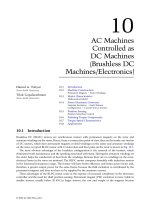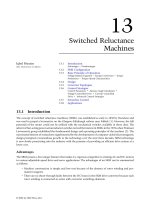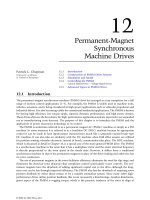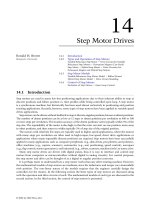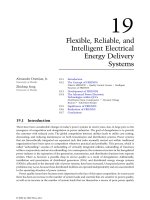How electronic things workb P1
Bạn đang xem bản rút gọn của tài liệu. Xem và tải ngay bản đầy đủ của tài liệu tại đây (571.03 KB, 50 trang )
HOW ELECTRONIC THINGS
WORK . . . AND WHAT TO
DO WHEN THEY DON’T
This page intentionally left blank.
HOW ELECTRONIC
THINGS WORK . . .
AND WHAT TO DO
WHEN THEY DON’T
ROBERT L. GOODMAN
Second Edition
McGraw-Hill
New York Chicago San Francisco Lisbon London Madrid
Mexico City Milan New Delhi San Juan Seoul
Singapore Sydney Toronto
Copyright © 2003 by The McGraw-HIll Companies, Inc. All rights reserved. Manufactured in the United States of
America. Except as permitted under the United States Copyright Act of 1976, no part of this publication may be
reproduced or distributed in any form or by any means, or stored in a database or retrieval system, without the prior
written permission of the publisher.
0-07-142924-7
All trademarks are trademarks of their respective owners. Rather than put a trademark symbol after every occur-
rence of a trademarked name, we use names in an editorial fashion only, and to the benefit of the trademark
owner, with no intention of infringement of the trademark. Where such designations appear in this book, they
have been printed with initial caps.
McGraw-Hill eBooks are available at special quantity discounts to use as premiums and sales promotions, or for
use in corporate training programs. For more information, please contact George Hoare, Special Sales, at
or (212) 904-4069.
TERMS OF USE
This is a copyrighted work and The McGraw-Hill Companies, Inc. (“McGraw-Hill”) and its licensors reserve all
rights in and to the work. Use of this work is subject to these terms. Except as permitted under the Copyright Act
of 1976 and the right to store and retrieve one copy of the work, you may not decompile, disassemble, reverse
engineer, reproduce, modify, create derivative works based upon, transmit, distribute, disseminate, sell, publish
or sublicense the work or any part of it without McGraw-Hill’s prior consent. You may use the work for your
own noncommercial and personal use; any other use of the work is strictly prohibited. Your right to use the work
may be terminated if you fail to comply with these terms.
THE WORK IS PROVIDED “AS IS”. McGRAW-HILL AND ITS LICENSORS MAKE NO GUARANTEES
OR WARRANTIES AS TO THE ACCURACY, ADEQUACY OR COMPLETENESS OF OR RESULTS TO BE
OBTAINED FROM USING THE WORK, INCLUDING ANY INFORMATION THAT CAN BE ACCESSED
THROUGH THE WORK VIA HYPERLINK OR OTHERWISE, AND EXPRESSLY DISCLAIM ANY WAR-
RANTY, EXPRESS OR IMPLIED, INCLUDING BUT NOT LIMITED TO IMPLIED WARRANTIES OF
MERCHANTABILITY OR FITNESS FOR A PARTICULAR PURPOSE. McGraw-Hill and its licensors do not
warrant or guarantee that the functions contained in the work will meet your requirements or that its operation
will be uninterrupted or error free. Neither McGraw-Hill nor its licensors shall be liable to you or anyone else for
any inaccuracy, error or omission, regardless of cause, in the work or for any damages resulting therefrom.
McGraw-Hill has no responsibility for the content of any information accessed through the work. Under no cir-
cumstances shall McGraw-Hill and/or its licensors be liable for any indirect, incidental, special, punitive, conse-
quential or similar damages that result from the use of or inability to use the work, even if any of them has been
advised of the possibility of such damages. This limitation of liability shall apply to any claim or cause whatso-
ever whether such claim or cause arises in contract, tort or otherwise.
DOI: 10.1036/0071429247
The material in this eBook also appears in the print version of this title: 0-07-138745-5.
Want to learn more?
We hope you enjoy this McGraw-Hill eBook! If you d like
and websites, please click her
e.
more information about this book, its author, or related books
,
Dedication
This book is dedicated to my brother, Bill,
for giving me the idea to write this kind of book.
This page intentionally left blank.
vii
CONTENTS
AT A GLANCE
Detailed Contents ix
Preface xv
Acknowledgments xvii
Introduction xix
1 Introduction to very basic electronics “101” 1
2 Radio/audio/stereo/speakers/music systems and
cassette player operations 49
3 Audio/video and CD player operation 91
4 How color TVs, digital HDTV receivers, and PC monitors work 115
5 Flat panel monitor/large screen projection set 161
and HDTV digital TV system operation
6 Direct broadcast satellite (DBS) system operation 195
7 How video cameras and camcorders work 227
8 Wired telephones, cordless phones, answering machines,
and cellular phone systems 259
9 How remote-control systems work 311
10 Printers, copiers, and fax machine operations 329
11 Digital video disc (DVD) system operation 363
12 General electronics and and maintenance information 381
Glossary 391
Index 415
For more information about this title, click here.
This page intentionally left blank.
DETAILED CONTENTS
ix
Chapter 1 Introduction to very basic electronics “101”
How resistors work
●
Reading resistor color codes
●
Resistor problems
●
Electronic circuit-protection devices (fuses)
●
How capacitors work
●
Tips for locat-
ing faulty capacitors
●
Transformer and coil operations
●
Transformer troubles
and checks
●
Transistors, ICs, and diodes
●
How transistors and solid-state
devices work
●
Solid-state scope sweep checker
●
Electronic power supplies
●
Electronic circuit soldering techniques
●
Surface-mounted devices and their
soldering techniques
●
Electronic test meters (VOMs)
●
Tools for electronic circuit
repairs
●
Some electronic service repair tips
●
Intermittent temperature problems
●
Noisy ICs or transistors
●
Testing equipment that intermittently blows fuses
●
Power supply trouble repair tips
●
Digital circuit power supplies
Chapter 2 Radio/audio/stereo/speakers/music
systems and cassette player operations
Broadcast radio transmitter operation
●
FM/AM radio receiver operation
●
Radio
circuit operation
●
IF amplifiers
●
Ratio detector operation
●
Composite amplifier
function
●
Biplex detector operation
●
Dolby recording technique
●
Audio
recording
●
How a Dolby recording is produced
●
Tips for making your audio sound
better
●
Stereo speaker placement
●
FM radio antennas
●
Receiver trouble
checks and tips
●
Intermittent receiver problems
●
Some receiver service don’ts
●
Loudspeaker concepts and precautions
●
How tuned-port speaker systems work
●
Bose Acoustic Wave speaker system
●
Bose series III music system
●
Bose
Lifestyle 901 system
●
Bose home theater system
●
Cassette player operation and
maintenance
●
Cassette tape recorder circuit operation
●
Tape player electronics
●
Cassette belt and rubber pulley drive systems
●
Fast forward not working
●
Tape
will not rewind properly
●
Demagnetize the tape heads
●
Tape head cleaning
and maintenance
●
Operation of the Trackmate cleaning cassette
●
Audio cassette
problems, solutions, and corrections
●
No tape movement or sound
●
Sluggish
tape rewind
●
No fast forward action
●
Auto shut-off not working
●
Checking the belt
drives
●
Notes on cassette switch problems
●
Unit will not load cassette car-
tridge
●
Cassette recorder blows fuses
●
Deck shuts down after a few seconds
●
A smoking cassette unit
●
Noise problems
●
Rewind and fast-forward problems
●
Erratic tape speed
●
Poor recordings
●
Cassette tape recorder problems
Chapter 3 Audio/video and CD player operation
How CD and laserdisc players work
●
Skip, search, and scan operation
●
How the
laserdisc is made
●
Signal (pit) detection scheme
●
Optical pickup and detection
via the pit signal
●
The laserdisc pits
●
Types of CDs
●
How the pickup carriage
functions
●
How the mechanical subchassis works
●
Mechanical tray operations
●
Pickup carriage operation
●
Tray operation
●
Notes on spindle operation
●
Pickup
For more information about this title, click here.
lens cleaning of the laserdisc player
●
DVD discs
●
DVD technology
●
Laser
light and laser diode information
●
Typical CD player
●
Power supply
●
Optical
deck
●
Electronics PC board
●
Disc motor
●
Spindle platform table
●
Sled
mechanism
●
Pickup motor
●
Disc clamper
●
Optical pickup unit
●
CD player
problems and solutions
●
Dead CD player
●
Command operation failure
●
Drawer will not open or close
●
Unpredictable drawer operation
●
Drawer will not
close properly
●
Various intermittent operation modes
●
Problems develop after
unit heats up
●
CD player audio problems
●
A review of common CD player
problems
●
Checking and cleaning the laser player
●
CD player will not operate
(start-up)
●
The CD sequence start-up routine
●
Notes on CD readout failures
●
CD skipping problems
●
CD noise problems
●
Optical-pickup sled comments
Chapter 4 How color TVs, digital HDTV receivers, and
PC monitors work
The color TV signal
●
Color TV signal standards
●
Color TV receiver operation
●
The
tuner section
●
IF and video stages
●
Video detector
●
Video amplifiers
●
Luma
delay line
●
Chroma processing circuits
●
Chroma and luminance stages
●
Color-killer circuit operation
●
Sandcastle circuit operation
●
Functions of the
sync circuits
●
Vertical sweep deflection operation
●
Horizontal sweep deflection
operation
●
Sound converter stage operation
●
Sound IF amplifier operation
●
Audio detector
●
Audio amplifier stage
●
TV power-supply operation
●
Sweep
circuits and picture tube operations
●
Loss of the vertical raster
●
Troubleshooting
horizontal sync troubles
●
Deflection yoke problems
●
Key voltage readings
●
Inoperative computer monitor problem
●
Testing sweep high-voltage transformers
●
More monitor problems
●
Checking out the high-voltage diode multipliers
●
High
voltage problems
●
Horizontal oscillator, driver, and output stage problems
●
TV
start-up problem
●
Measuring the TV set high voltage
●
Blurred, out-of-focus picture
symptom
●
Switching transformer checks
●
Vertical sweep section operation
●
How the vertical drive signal is developed
●
Vertical picture-tube scanning
●
How
the color picture (CRT) works
●
CRT electron gun operation
●
In-line CRT gun
assembly
●
Large-screen projection TV operation
●
Light path of a projection
TV set
●
Liquid-cooled projection tubes
●
Optical CRT coupling
●
Self-conver-
gence design
●
Picture brightness and the projection screen
●
A list of TV receiver
problems and solutions
●
Digital/HDTV operation and review
●
HDTV picture
quality
●
Set-Top converter box
●
Digital video formats
●
Digital TV signal
●
Digital
TV compatibility
●
Introduction to DTV delivery systems
●
The status of NTSC TV
broadcasts
●
Standard-definition and high-definition basics
●
Digital television
questions and answers
Chapter 5 Flat panel monitor/large screen projection set
and HDTV digital TV system operation
Introduction to flat screen HDTV and monitor displays
●
Current plasma panel
technology
●
Plasma panel programming
●
Plasma monitor adjustments
●
HDTV digital video processing
●
Tips for plasma panel installation
●
Plasma HDTV
maintenance tips
●
Flat panel LCDs displays
●
Digital chip TV projection system
●
Basic TV projection system
●
The optical light path
●
Projection TV lens system
●
Liquid-cooled projection CRTs
●
Special projection screen details
●
Projection set
digital convergence
●
Simplified digital convergence
●
Digital television (HDTV)
system overview
●
HDTV picture improvement
●
Analog/digital set-top conversion
X CONTENTS
box
●
HDTV video formats
●
Over-the-air television signals
●
The compatibility
question
●
Receiving the digital signal
●
Various HDTV formats
●
Future NTSC TV
reception
●
HDTV and NTSC transmission basics
●
Simplified HDTV transmitter
operation
●
The HDTV basic audio system
●
Digital audio signal processing
●
Digital audio processing
●
The sampling process
●
Quantized binary sampling
●
Audio signal coding
●
Using audio compression
●
Recovering digital audio
●
Some
HDTV questions and answers
●
Recap of the digital DTV and HDTV systems
Chapter 6 Direct broadcast satellite (DBS) system operation
Introduction to satellite TV
●
Keeping the satellite on track
●
Powering the satellites
●
DBS satellite overview
●
How the satellite system works
●
Operation of the
RCA DBS system
●
Ground station uplink
●
MPEG2 video compression
●
Data
encryption
●
Digital data packets
●
The DirecTV satellites
●
Dish operation
●
Low-noise block (LNB)
●
DBS receiver circuit operation
●
The receiver modem
●
Diagnostic test menus
●
Customer-controlled diagnostics
●
Controlled diagnostics
for troubleshooting
●
Service test
●
Using the front-panel control buttons
●
Pointing
the dish
●
A world view of the DSS system
●
Front-panel receiver controls
●
Connecting the satellite receiver for operation
●
Readjusting and fine tuning the dish
position
●
Video display dish alignment
●
Aligning the dish with the video display
●
Aligning the dish with an audio tone
●
Some possible DBS system problems and
solutions
●
DBS Glossary
Chapter 7 How video cameras and camcorders work
Camcorder features and selections
●
Digital video images
●
Sharp model VL-DC1U
digital camcorder
●
Video camera/camcorder basics
●
What is a camcorder?
●
Determining which camcorder section is faulty
●
Performance check out
●
Video
camera functional blocks
●
Lens/iris/motors
●
Sync generator circuitry
●
Camera pick-up devices
●
Developing the video signal
●
How the color signal is
developed
●
Repairing and cleaning your camcorder
●
Taking your camcorder
apart for cleaning and repairs
●
Cleaning the camcorder heads
●
Tape will not
move and no viewfinder picture
●
Camera auto-focus operation
●
Slide switches
and control buttons
●
Cassette not loading properly
●
Intermittent or erratic
operation
●
Camcorder motors
●
Sony Handycam servicing
●
Camcorder troubles
and solutions
●
Camcorder care tips
Chapter 8 Wired telephones, cordless phones, answering machines,
and cellular phone systems
Telephone system overview
●
Tip and ring connections
●
Telephone ringer (bell)
●
The hook switch
●
Telephone handset and touch-tone pad
●
Conventional
telephone block diagram
●
Conventional telephone troubles and solutions
●
Static and phone noise checks
●
Low sound or distortion
●
DTMF touchpad
problems
●
Electronic telephone operation
●
Electronic telephone troubles and
repair tips
●
Noisy phone operation
●
No phone operation (dead)
●
Touch-tone
pad problems
●
How a phone answering machine works
●
Conventional tape
machine operation
●
Play/record operation
●
Cassette tape operation overview
●
Cleaning the tape mechanical system
●
Digitized tapeless answering machines
●
Various answering machine troubles and solutions
●
Cordless telephone
overview
●
Some cordless phone considerations
●
Cordless phone problems
and answers
●
Some new and different phone technologies
●
Security codes now
CONTENTS XI
being used
●
Cordless phone sound quality
●
Deluxe cordless phone features
●
Cordless phone buying tips
●
Basic cordless phone operation
●
Cordless phone
base unit circuitry
●
Portable handset unit
●
Cordless phone troubles and correction
hints
●
Removing the phone case
●
Cordless phone trouble checklist
●
Handset
and base unit will not communicate (two beeps)
●
Phone will not operate (dead)
●
Noise or static problems
●
Phone will not ring
●
Phone will not work (dead)
●
No
dial tone
●
Phone interference review
●
Cordless phone antenna replacement
●
Phone surge protection
●
Mobile radio telephone communications
●
Two-way
radio trunking system
●
800-MHz trunking system overview
●
Trunking telephone
interconnect
●
The cellular telephone radio system
●
How the cell phones operate
●
Transmit/receive section
●
CPU and memory logic
●
Some cell phone tips for
poor, noisy, or intermittent reception
●
Battery talk
●
Drop-out and dead reception
areas
●
Personal communications service (PCS)
●
Browsing the Internet
●
PocketNet portables
●
EarthLink wireless service system
●
Cell phones that “glow”
in the dark
●
Dual cell phones
Chapter 9 How remote-control systems work
How remote-control systems operate
●
The ultrasonic remote transmitter
●
The
infrared (IR) remote-control transmitter
●
What to do when the remote control will
not work
●
Universal remote-control device
●
How to program the universal
remote
●
Remote-control care and maintenance
●
Remote-control extenders
●
Transmitter and receiver extender installation
●
What to do if you have trouble
with the extender
●
Intelligent remote-control system
●
Operations of Philips
Pronto remote
●
Sony’s RM-AV2100 universal learning remote
●
Programming
the learning remote
●
Tips on MACRO programming
●
Designing user-friendly
macros
●
Programming the Sony universal learning remote
●
Viewing cable TV
programs
●
Viewing DVD programs
●
Viewing VCR tapes
●
Scrolling com-
mands for the Sony RM-AV2100 learning remote unit
●
Building your own secret
commands
●
Radio Shack VCR programmer
Chapter 10 Printers, copiers, and fax machine operations
Daisywheel printer operations and tips
●
Datadisks
●
Keyboards
●
Printwheel
●
Platen cleaning
●
Monitor screen
●
Check list for PWP machines
●
How the ink-jet
(bubble) printer works
●
Print cartridge and nozzles operation
●
Ink-jet head
problems
●
Ink-jet printer problems
●
Paper-handling problems and checks
●
Print-head carriage assembly problems
●
Multi-pass troubleshooting tips
●
Printout
is wrong
●
Print job vanishes
●
Bubble-jet print jobs disappear under windows
●
Characters on screen do not match printed characters
●
Printout does not match
paper size
●
The machine will not print anything
●
Cannot print from the file
menu in a windows application
●
Printout is too light
●
Disconnecting the printer
port
●
Uninstalling the multipass desktop manager
●
Uninstalling program for
Windows 95
●
Diagnosing software and hardware problems
●
Multipass diagnostics
for Windows 95
●
Plain-paper-fax-machine operation
●
Fax modem operation
●
Some fax modem problems
●
Fax machine operational panel
●
Some fax problems
and solutions
●
Unable to send documents
●
Images sent are dirty or spotted
●
Cannot receive documents automatically
●
Cannot receive documents manually
●
Nothing appears on the printed page
●
You cannot make copies
●
Fax machine
will not work (dead)
●
Fax machine paper is jammed
●
Paper jammed in printer
area
●
Dot-matrix printer operation
●
Dot-matrix printer block diagram
●
Print-head
operation
●
Overall system overview
●
Printers/print head troubles and tips
●
XII CONTENTS
How laser printers work
●
Laser printer block diagram operation explanation
●
Photosensitive drum operation and care
●
Looking inside the laser printer
●
The
laser printer control circuits
●
Controlling the printer with the microprocessor
●
How
images are transferred onto paper
●
Notes on cartridge usage
●
Color printer
overview
●
Color laser printer operation
●
Laser printer problems and tips
●
Printer
will not turn on (dead)
●
Paper is jammed or has tears
●
Prints have splashes and
specks
●
Scanner operation
●
Three types of scanners
●
The flatbed scanner
●
Top-of-the-line scanners
●
Connecting the scanner to the computer port
●
Scanner review
Chapter 11 Digital video disc (DVD) system operation
The DVD player
●
Sound channels
●
Parental lock
●
DVD player operation
●
Signal processing
●
Servo and optical pick-up electronics
●
RF signal processor
●
DVD digital signal processor
●
MPEG technology
●
Encoding and decoding
●
Laser
injection diodes
●
Caution when working around lasers
●
Construction and opera-
tion of the DVD disc
●
DVD disc operation review
●
DVD troubleshooting trouble
symptoms and corrections
●
Personal video recorder (PVR)
Chapter 12 General electronics service and maintenance information
Tips on locating, repairing, and adjusting common problems that “crop up” in
consumer electronics products in the home and office
CONTENTS XIII
This page intentionally left blank.
PREFACE
I think you will find this book unique in its simple explanations and its many
easy-to-understand illustrated drawings and photos of how electronic equipment
works in the home or office.
The brain storm for this type of book was started many years ago when my
brother wanted to know how a picture was formed on a color TV. The planning,
development, and portions of the drawings and writing for the first edition were in
progress for eight years. The actual writing and production of the many photos
and drawings took over two years.
The mission of the second edition remains to take the mystery out of how elec-
tronic consumer products work, for persons with little or no electronic background.
Not only does this book give you simplified electronic equipment operations, but
hints and tips about what to check when the device does not work properly or
does not work at all. There’s also information about how and what to clean, plus
preventive maintenance that can be done to extend the life of these very expensive
products. The book includes tips on how to protect products from voltage surges
and lightning spike damage.
This is a basic “how electronics works” book for the consumer who buys and
uses the many wondrous electronic product devices now found in most homes and
offices. You now have in your hand a book with over 50 years of my electronic
troubleshooting experience and information culled from over 60 of my published
electronics books. Thus, this is a book that just about everyone needs to keep on
their home or office bookshelf or desk.
The simplified technical electronics information and service tips you obtain
from this book can help you in dealing with electronics technicians or service
companies when you need professional service for the repair of your equipment.
This might save you repair costs because service personnel will not be able to
“pull the wool over your eyes,” so to speak, since you will be better technically
informed. Thus, service repair estimates and costs may swing in your favor. Also,
the knowledge gained from this book might help to determine if you should repair
a faulty device or purchase a new one.
Finally, this is a valuable book for the hobbyist, electronic experimenter, or any
person interested in entering the wonderful world of electronics as a career.
Bob Goodman, CET
Hot Springs Village, AR
This page intentionally left blank.
ACKNOWLEDGMENTS
Many thanks to the following electronics companies for furnishing some of the
technical circuit information, drawings, and photos: Zenith Electronics Corp.,
Thomson Multimedia Corp., Sencore Electronics, Inc., and Bose Acoustic Wave
Music Systems.
Many thanks to the electronics instructors and electronics service technicians
that I have had the pleasure of meeting during the seminars that I have given for
many years in all parts of the nation.
This page intentionally left blank.
INTRODUCTION
This new edition is designed for anyone who wants simple explanations of how
electronic equipment in the home and office works. Following is a chapter-by-
chapter description of the wealth of information in this book that will take the
mystery out of electronic consumer products.
Chapter 1 gives you a basic introduction to electronics—“Very Basic
Electronics 101.” The chapter contains photos and drawings of the components
found in your electronic devices with explanations of what they do, how they are
constructed, and how to test them. You’ll be shown how to use a volt-ohm meter
(or multimeter) to check the voltage and resistance found in electronic circuits.
You’ll learn how to build a simple circuit tester in order to check solid state
devices such as transistors, diodes, and ICs.
Chapter 2 is an overview of how FM radio signals are developed and received on
a stereo radio. You’ll get tips on radio repair and a look at the Dolby audio system.
You find out how loudspeakers work and how the advanced Bose Acoustics radio
and speaker systems operate. The chapter concludes with an explanation of how
cassette recorder/player machines work, audio cassette trouble symptoms, cor-
rective action, and care and cleaning of these units.
Chapter 3 introduces you to the operation of audio and video laser disc players
and compact discs (CDs) and how to clean them and perform minor repairs.
You’ll get hints on keeping your CD operating smoothly and a list of common CD
problems and their solutions.
Chapter 4 contains an overview of color TV signal makeup, the components
within the signal, and some of the various worldwide color TV standards. The
stages that make up color TV set operation are explained via a block diagram that
helps walk you through the circuit operations. You’ll delve into horizontal and
vertical sweep circuit operations, color picture tube operation, and how a color
picture is developed on the screen. A preview of large-screen projection receiver
operations follows. The chapter concludes with a list of typical color TV and PC
computer monitor trouble symptoms and their solutions.
In Chapter 5 you’ll learn about flat screen plasma TV/monitor devices, large
screen projection sets, and the new digital HDTV system operations. You’ll see
how the plasma flat screen develops a TV picture and learn how to make adjust-
ments. The chapter concludes with a series of HDTV questions and answers.
Chapter 6 has information on the new and exciting Digital TV DirecTV
Satellite (DSS) transmission system and its operation, including an overview of
the uplink earth station, the satellite that receives and retransmits the signals, and
the dish/receiver that picks up the downlink signals. Detailed drawings will help
you connect the DSS receiver to your TV receiver and VCR recorder.
In Chapter 7 you’ll get a look at past and present video cameras and cam-
corders and review various features of this equipment, such as older models with
vidicon pickup tubes and modern CCD solid-state image pickup chips and digital
video cameras. You’ll learn how camcorders work and how to perform minor
repairs and clean recording heads.
Chapter 8 explains the telephone landline system and home phone operation
and describes how the electronic phone works. You’ll find out how to determine
whether your phone or the phone company line to your residence is at fault. You’ll
learn how answering machines and cordless telephones work. All types of phone
problems and their solutions are covered.
Chapter 9 covers the various remote control units used for operating TV
receivers, CD players, DVD players, set-top boxes, cable control boxes, VCRs,
and DSS satellite dish receivers.
Chapter 10 reviews basic printer, copier, and fax machine operation. You’ll
find out how the “Daisywheel,” ink-jet, dot-matrix, laser, and color laser printers
operate and how to troubleshoot them. The chapter concludes with information on
the operation of copiers, scanners, and fax machines.
Chapter 11 gives you an inside look at DVD video player operation, DVD disc
construction, and how the laser beam reads disc information.
Chapter 12 contains general electronic service and maintenance information that
you will find useful for keeping your electronic devices in good working order.
XX INTRODUCTION
1
INTRODUCTION
TO VERY BASIC
ELECTRONICS “101”
1
CONTENTS AT A GLANCE
How Resistors Work
Resistor types
Reading resistor color codes
Resistor problems
Electronic Circuit-Protection Devices
(Fuses)
Testing the fuse
How Capacitors Work
Type of capacitors
Capacitor circuit diagram symbols
Tips for locating faulty capacitors
Transformer and Coil Operations
Transformer troubles and checks
Transistors, Integrated Circuits
(ICs), and Diodes
Diodes
Metal-oxide varistor (MOV) operation
How Transistors and ICs (Solid-State
Devices) Work
The integrated circuit (IC)
Solid-State Scope Sweep Checker
Electronic Power Supplies
Half-wave power supply
Full-wave power supply
A bridge-type power supply
The voltage-doubler power supply
Electronic Circuit Soldering
Techniques
Surface-mounted devices and their
soldering techniques
Electronic Test Meters (VOMs)
Tools for Electronic Circuit Repairs
Some Service Repair Tips
Intermittent temperature problems
Noisy ICs or transistors
Testing Equipment that Intermit-
tently Blows Fuses
Power Supply Trouble Repair Tips
Digital Circuit Power Suppliers
How Resistors Work
Resistors are made in various shapes, sizes, resistance values (in ohms) and wattage rat-
ings. Resistors are the most common electronic circuits. In fact, ICs have many resistors
inside them. Resistors are used as current-limiting devices and an electronic circuit will
not work without them. You might think of a resistor as a control device that limits current
flow to the circuit load. A circuit load provides the work; it can be a light bulb, motor, loud
speaker, transistor, or IC. Resistor values are in ohms and are made of carbon or coils of
resistance wire. Resistor values can be fixed or adjustable (as with a rheostat or like a vari-
able volume control used on a radio or TV). The value in ohms of a resistor is what will
determine the electron current. A low resistance will cause a large current to flow, and a
high resistance will cause a small current flow.
RESISTOR TYPES
Many types, values, and sizes of resistors are used in electronic products. The photo in
(Fig. 1-1) shows various wattage sizes of carbon and flameproof resistors from
1
⁄4-watt to
2-watt ratings. These fixed resistors are made to a specific resistance value and cannot be
changed. The resistance value is indicated by color-coded bands or stamped numbers on
the side of the resistors body. The symbol for a fixed resistor is shown in Fig. 1-2. The
larger, 10- to 300-watt, power resistors are shown in Fig. 1-3.
2 INTRODUCTION TO VERY BASIC ELECTRONICS “101”
1/4-watt flameproof resistor
1/2-watt carbon resistor
2-watt flameproof resistor
1-watt flameproof resistor
2-watt carbon resistors
1-watt
FIGURE 1-1
Various types and wattages of resistors.
HOW RESISTORS WORK 3
1-watt 2600 ohms
Carbon Resistor
FIGURE 1-2
A schematic symbol of a fixed resistor.
.1 power resistor
1.6-ohm 300-watt resistor
50-ohm power resistor
Resistor Symbol
FIGURE 1-3
Drawings of high-wattage resistors.

